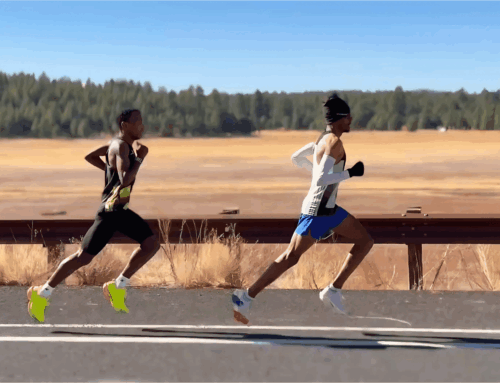Dr. Jack Daniels likes to refer to racing as “simply an expression of all your hard work.” Coaches will often use “the hay is in the barn,” at the end of a long training block to let their runners know the work is done and they’re ready to race. These are great ways to make athletes less anxious in the final week or days before a major race. The irony is that despite countless hours and focus on improving fitness for a race, many runners are ready to improve but end up underperforming due to lack of focus on race strategy. When we think about race strategy, it’s not just about pacing in a race, but how you prepare for the course mentally and physically, how you warm-up, and stay focused during the race.
Prepare for the course, not just the distance
Beyond the fitness preparation, or the training you put in to prepare your body to achieve a time goal over a specific distance, you also have to prepare your body for the terrain. For instance, track racing requires a lot of work on a track. Cross country runners spend a lot of time training on surfaces they have to race on, like grass, dirt, cinder, etc. Marathon runners have to prepare for the roads when it comes to the stress of impact from the surface and the undulation. When it comes to cross country and marathoning terrain is even more of a factor, so it’s more important that your race strategy covers doing the necessary work on terrain similar to your goal race. Even if the course if flat, like the Berlin Marathon or a flattish cross country course, you must do a lot of work on flat terrain to prepare your muscles.
Warming up should be individualized
Never assume runners should follow the same warm-up routine. Design a warm-up routine that works well for you. Every runner and coach should experiment with a variety of routines to see what works best. A warm-up should prepare each participant, both physiologically and mentally for the task at hand.
A mental approach that works well for some runners is to go over a race in their mind which they had a positive experience. Rerun the race in your mind and remember what made it so satisfying. Practice this, not just on race day but in weeks leading up to the race.
Most runners can feel when their muscles are warmed up and when they need a little more time going easy or hard. It typically takes about 10 mins for the running muscles to start increasing their temperature. A couple of degrees will aid performance, but increasing muscle temperature more than a couple of degrees can lead to subpar performance. For a relatively long race, you certainly don’t want to start the race with a body temp too high or you will quickly become overheated. Just as different runners lose fluids at different rates, some warm up more quickly than others, and every individual needs to experiment with different warm-up routines to see which works best under different conditions.
Sometimes starting the race a little slower, brings you to the finish line faster
It is very common for runners to go out too fast in a race leading to a slower finishing time than they were capable of. We always encourage a more moderate or evenly paced effort but it takes practice and visualization to execute properly. In Daniels’ Running Formula, Jack’s unique pace strategy for his cross country runners led to a national championship. It’s a great lesson on starting slower to get to the line faster…
I measured off the first 400m of the course and the last thing I asked my women’s team to do was run a steady 800m, going through 400m in 85 seconds, which would be about a 17:42 5k if they held the whole way. I encouraged them not to go any faster when the race began, which was about 10 minutes after completing the 800m warm-up run.
When the race started, my seven runners all went through the first 400m between 84 and 87 seconds and they were the last seven runners in the field of more than 180 runners. Some of the front runners went out in under 75 seconds, and all others were between 75 and 82 at the 400m mark. At the first mile mark, one of my runners was leading the entire pack, and she went on to win by more than 20 seconds (17:20). My next runners placed 5th, 8th, 15th and 26th and winning the team title was a cinch.
Focus on the task at hand
It is always better to think about what you are doing (breathing rhythm, stride rate, maintaining posture, keeping relaxed arms, running tangents etc.) than to worry about how much further you have to go or how far you’ve gone so far. Don’t judge your race by what others are doing, judge by what you are doing and what you are feeling.
Lastly, if you pace well early you always have an extra gear deep down if you reach for it. Races take distance, timing, discipline, and trust. The smartest runners know when to think, and when to let go.





Great article!